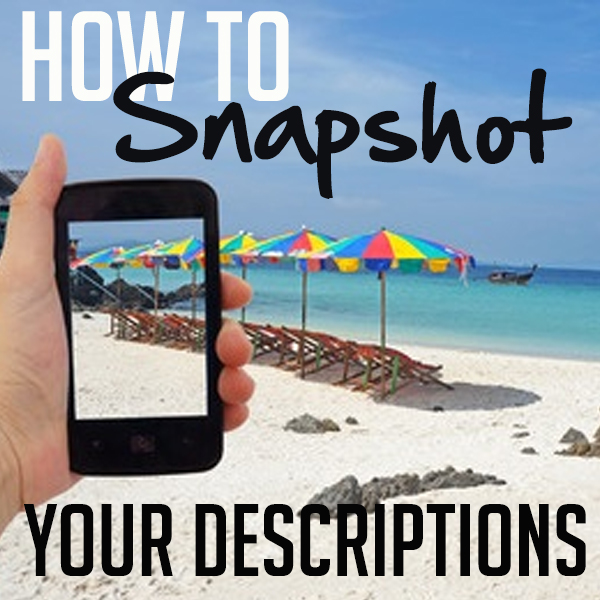A Quick and Easy Tool for Writing Description (part 2)
This month we’ve been talking about Extreme Scene Makeover and diving into description. I introduced the acronym FOCUS, a tool I use to help me write description. We covered F-O-CU on last week’s post (here).
First step in writing great description is to put it through the POV of your character. It’s all about how they feel about being there. We layer in their attitude while they describe the scene.
Once you add in perspective, then you need to dig deep into the description.
Today, let’s talk about the final and most powerful element of FOCUS: Symbolism, and how to use it to connect your reader emotionally to the description (and thus use description as another tool for emotional layering in your scene!)
In your story, you’re actually trying to communicate more than with words – you’re trying to cement a feeling for them. It’s part of the trick you play on your reader – you subtly embed a feeling, an emotion into the world that will help you build the emotions of the character.
Word pictures are how you’ll communicate the impact the scene has on your character, and thus, your reader. Here’s another way to look at it: It’s the way that your character perceives the person, place or thing, summed up in a symbol.
Consider this passage:
The night had turned crisp as he walked home late under the lamplights. He’d retired the coupe in Uncle Jimmy’s garage two blocks away and carried the coat box under his arm, his collar turned up. Snow, soft, almost ethereal, drifted from the sky, turning to diamonds under the streetlights.
The Close up – (snow under the streetlights) is turned into a word picture that conveyed the POV character’s mood. He’s happy. He’s giving his girlfriend this expensive coat. And he feels like a provider.
The word picture conveys the feeling or mood of your character as he relates to the scene.
How do you find it? How do you build it?
First, look at your descriptive nouns and verbs….they might help you find that symbol. Snowflakes are easy – they’re white and they dazzle. So, what else is white and dazzles? Diamonds.
Once you have the Symbol, how do you apply it?
- Direct Association:
Dino stared at the commander, his helmet pushed back to reveal muddy, dark hair, dark blue eyes. His face bore days of filth, grime embedded in his grizzle, and he reeked of swamp and blood and smoke. The batter only made him appear a bona fide hero.
This is an easy symbolism – I just say it – he’s a hero. Sometimes we just say the word picture right out.
- Implied: But sometimes, and better, it’s implied. It’s when we go deeper to say, what’s the meaning behind the symbol. And, can we use it without explaining the meaning?
Consider this scene: The POV is fleeing from his home, trapped by his past, headed to an unknown future. In this passage, the symbol, the Albatross signifies his desire for escape.
Most days, he wrapped himself into his blanket—the knitted wool a mockery against the shearing wind—and traced the mischief of the seabirds. Markos watched as the birds dipped into the troughs between the waves and let themselves be lured to the stern of the boat by children offering biscuits and smoked herring smuggled from the breakfast table. Once he’d spied an albatross, and something about the great width of its wings, riding the gales without effort, lodged a bullet in his throat.
Consider this implied symbol in the passage. The POV is lying on the sidewalk after just being thrown out of a bar fight that he started. He’s ashamed and wants to just disappear:
He skidded across the sidewalk, rolled, and landed on his face in the blackened snow. Shards of ice cut his skin even as he lay there, breathing in blades of air. Blood ran into his mouth, his lip split. His eye burned, and he couldn’t see out of it. And when he breathed in, his body turned to flame. He rolled over, sprawling on the sidewalk, his pulse slowing enough now to taste his broken parts. Overhead the stars still winked at him, as if saying, yes, Dino, we see you. He raised his arm, his fingers slowly closing over one, the brightest, until finally, he snuffed it out.
He doesn’t want heaven looking at him.
Ask: How can you use symbolism to convey a deeper message? This is the heart of showing.
If you’d like an in-depth class on description, check out our Storyworld video series!
Go! Write something Brilliant!
PS—we’re opening our highly acclaimed Online Storycrafter’s Program for new students in early September. If you’re interested in being notified when the course opens, click HERE.


Comments 1
Very useful tips!